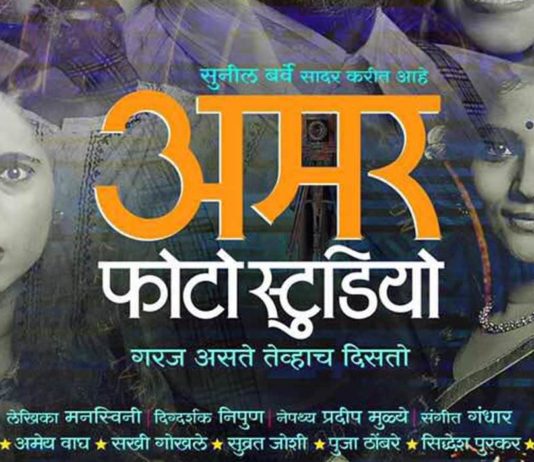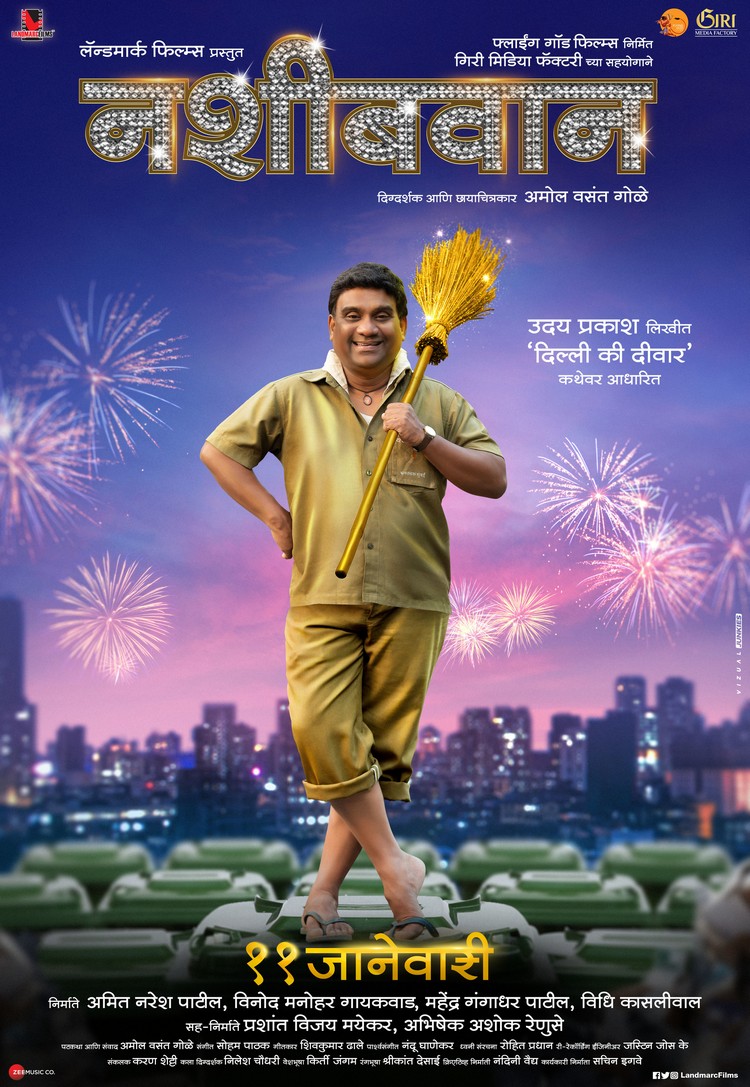Vikram Gokhle (occasionally credited as Vikram Gokhle) is a well known Indian film, television and stage actor, notable for his roles in Marathi theatre and Hindi films and television. He is the son of another well known veteran Marathi theater and film actor Chandrakant Gokhle, who acted in 68 Marathi and 16 Hindi films besides 64 Marathi. Sangeet Natak in Marathi language literally means Musical Drama. As the name suggests, this form of drama combines prose as well as poetry in form of songs to convey the story. In a manner, they are very much similar to Musicals. Sangeet Natakas played a vital role in the development of Marathi theater and thus the Marathi cinema as well as. A poor working man loses his job and decides to start a theater troupe. Khabardaar (2005) Error: please try again. A simple truck driver Maruti Kamble is accused for a murder and has to run for his life the only person who can help him is the crime reporter Bharat but it wont be easy for Maruti to find Bharat. It is getting difficult for Indira to accept modern ways of life and longs for her son and his family to come and live with her. TISRE BADSHAH HUM The play depicts the story of Urmi, Charu, and Samar. Urmi and Charu are two young girls in their mid-twenties, staying in Mumbai in a rented apartment.
| Born | Kashinath Ghanekar 14 September 1930 |
|---|---|
| Died | 2 March 1986 (aged 56) Amravati, Maharashtra, India |
| Occupation | Theatre, movie actor |
| Spouse(s) |
|
| Children | Rashmi Ghanekar |
Dr. Kashinath Ghanekar (14 August 1930 - 2 March 1986[1][2]) was a popular stage actor and dental surgeon.[1]
Early life[edit]
Ghanekar was born at Chiplun and completed schooling there itself.
Personal life[edit]
He married twice. He was married to Irawati M. Bhide,[3] a gynaecologist and obstetrician.[4] His first marriage was childless and ended in divorce. He subsequently married a much younger Kanchan, the daughter of Marathi actress Sulochana Latkar. This marriage was in every way harmonious. After his death, Kanchan penned a biography titled 'Nath Ha Maza' meaning 'such was my husband.'[5]
Career[edit]
Kashinath was the first superstar of the Marathi stage with a lot of glamour, and he was the highest paid star from the years 1960 to 1980.[6] He appeared in Marathi films[7] in the 1960s. In addition to Marathi stage and movies, he appeared in Hindi movies such as Abhilasha opposite Nanda and Dadi Maa where he played the role of the son of Ashok Kumar and Bina Rai.
The role that made him a popular actor was that of Sambhaji in the play 'Raigadala Jevha Jaag Yete' (When Raigad awakens) written by the play writer, Vasant Kanetkar. Most notable character ever played by him was 'Lalya' in the play Ashroonchi Zhali Phule. Some of the other noted plays he acted in are - Ithe Oshalala Mrutyu, Garambicha Bapu, Anandi Gopal, Shitu, Tujhe Aahe Tujpashi, Sundar Mi Honar, Madhumanjiri etc.[8]
The film Madhuchandra (in 1968) made Ghanekar, a noted stage actor, a major Marathi film star.[9]
Death[edit]
Dr. Kashinath Ghanekar died due to a heart attack during one of the tours of his plays, at his hotel room at Amravati.
Cultural Depictions[edit]
Dr. Kashinath Ghanekar Natyagruha is a modern theater with an auditorium built by the Thane Municipal Corporation, which is situated at Hiranandani Meadows, Near Ghodbunder Road, Vasant Vihar, Thane West, Maharashtra 400607.
In other media[edit]
In November 2018, Ani... Dr. Kashinath Ghanekar a Marathi-language feature film was released; starring Subodh Bhave as Dr Ghanekar, Sonali Kulkarni, Sumeet Raghavan, Vaidehi Parashurami, Prasad Oak, Nandita Dhuri, Anand Ingale and Mohan Joshi in prominent roles. It is a biographical drama directed by Abhijeet Deshpande.
Marathi Comedy Drama List
Theatre[edit]
Below is a list of stage plays where Kashinath Ghanekar played a significant role. Year mentioned is when the Play was first performed on a public stage.
| Year | Name of Play |
|---|---|
| 1952 | Shitu |
| Tujhe Aahe Tujpashi | |
| Sundar Mi Honar | |
| Madhumanjiri | |
| Laxmi Aali Ghara | |
| 1962 | Raygadala jevha jaag yete |
| 1963 | Ashroonchi Zhali Phule |
| 1968 | Ithe Oshalala Mrutyu |
| 1972 | Garambicha Bapu |
| Guntata Hruday He | |
| 1976 | Anandi Gopal |
Filmography[edit]
| Year | Film |
|---|---|
| 1952 | Laxmi Aali Ghara |
| 1953 | Dharm Patni |
| 1963 | Maratha Tituka Melvava |
| 1964 | Paathlaag |
| 1965 | Padchaya |
| 1966 | Daadi Maa (Hindi) |
| 1967 | Madhuchandra |
| 1968 | Ekati |
| Preet Shikva Mala | |
| Abhilasha (Hindi) | |
| 1970 | Deo Manus |
| Garambicha Bapu | |
| Manla Tar Dev | |
| 1971 | Ajab Tuze Sarkar |
| Zep | |
| 1975 | Ghar Gangecha Kathi |
| 1976 | Ha Khel Savalyancha |
| 1978 | Chandra Hota sakshila |
References[edit]
- ^ ab'Uma & Prakash Bhende Remember Dr. Kashinath Ghanekar'. ZEE Talkies. Archived from the original on 1 July 2016. Retrieved 26 May 2016.
- ^'Archived copy'. Archived from the original on 10 June 2016. Retrieved 26 May 2016.CS1 maint: archived copy as title (link)
- ^'Archived copy'. Archived from the original on 12 October 2017. Retrieved 8 October 2018.CS1 maint: archived copy as title (link)
- ^'Archived copy'. Archived from the original on 29 June 2016. Retrieved 26 May 2016.CS1 maint: archived copy as title (link)
- ^'Archived copy'. Archived from the original on 12 October 2017. Retrieved 4 December 2017.CS1 maint: archived copy as title (link)
- ^'Ani… Dr. Kashinath Ghanekar Movie Review'. Pune Mirror. Archived from the original on 26 November 2018. Retrieved 26 November 2018.
- ^Gokulsing, K. Moti; Dissanayake, Adjunct Fellow East-West Center Hawaii Scholar in Residence Wimal; Dissanayake, Wimal (17 April 2013). Routledge Handbook of Indian Cinemas. Routledge. pp. 80–. ISBN9781136772849. Archived from the original on 28 June 2014. Retrieved 23 February 2014.CS1 maint: discouraged parameter (link)
- ^'Playwright at the centre: Marathi Drama from 1843 to the present'; Author Shanta Gokhale; Seagull Books Publishers. ISBN817046157 X
- ^Page 393, Encyclopaedia of Indian Cinema; Authors: Ashish Rajyadhyaksha and Paul Willemen; Oxford University Press; c. 2002. ISBN0-85170-669-X
9. Interview of Kanchan Ghanekar, wife of Dr. Kashinath Ghanekar

External links[edit]

| Sangeet Natak | |
|---|---|
Ghashiram Kotwal being performed at Bharat Bhavan, Bhopal | |
| Cultural origins | 19th century Maharashtra |
Sangeet Natak in Marathi language literally means Musical Drama. As the name suggests, this form of drama combines prose as well as poetry in form of songs to convey the story. In a manner, they are very much similar to Musicals. Sangeet Natakas played a vital role in the development of Marathi theater and thus the Marathi cinema as well as Indian film industry.[1] Sangeet Natak start with praise of Lord Natraja which is called as Naandi or Mangalaacharan or Suchakpad usually the famous one 'Panchatunda Nararundamaldhar' from Sangeet Shakuntal. They are popular for use of Indian classical music. The 'Dramatic Music' is called Natya Sangeet, one of the two popular forms of vocal arts in Maharashtra and surrounding states. The other is Bhavageet.
History[edit]
The beginning[edit]
Vishnudas Bhave is considered the founder of Marathi theater. In 1843, his group staged the first public performance of Marathi play Seeta Swayamvar (सीता स्वयंवर). The integration of music in the dramas took place quite late in 1879 when play writer and producer Trilokekar presented his musical play Nal-Damayanti (नल-दमयंती). It was the first musical play on Marathi stage.
But only when Balwant Pandurang Kirloskar (popularly known as Annasaheb Kirloskar) staged his first musical play Shaakuntal, based on Kalidas's play Abhijñānaśākuntalam, on October 31, 1880 in Pune did the trend of Sangeet Natak really start.[2] Kirloskar included 209 musical pieces in his Shaakuntal of 7 acts. They consisted of a mix of Hindustani and Carnatic classical music, and lighter music.
During its early period, Sangeet natak was dominated by religious plays like Sangeet Saubhdra, which is legend in Marathi sangeet natak.[citation needed] The trend changed with coming of sangeet Manapman, which depicts bravery of its hero Dheryadhar and his love with Bhamini which was written by Krushnaji Prabhakar Khadilkar.
Golden age[edit]
The new trend of Sangeet Natakas caught up with the popularity quite quickly. With British Raj then existing in India, Sangeet Natakas were compared with the Operas and thus local Marathi Indians found synonymous recreation. In the blooming times, Sangeet Natakas were mainly based on mythological stories of Mahabharata or Ramayana which would hence easily connect with the masses. They did not cover the complete epics but were limited to only small stories in them.
With popularity & success, experimentation started on stage with abandoning mythological themes and bringing social issues to audiences. Sangeet Sharada, for example, by portraying the feelings of a teenage girl to be married to a widower in his late seventies, brought out a social message. Few dramas, like Kichak Vadh, even agitated the British rulers to the extent that they were banned. Kichak Vadh compared the Britishers with Kichak, an evil character from Mahabharata who tried to dishonour Draupadi. Draupadi was then synonymous with the oppressed common Indian masses.
During the 1960s, another turn came in natya sangeet with the emergence of Jitendra Abhisheki, who was credited with applying simplicity to the complex composition of Natya Sangeet.
Plays[edit]

The recent play Katyar Kaljat Ghusli by Zee studios opened up a new era of musical cinemas. This movie was based on the legendary play bearing the same name. Its music was composed by Jitendra Abhisekhi and sung by Vasantrao Deshpande.
Notable contributions[edit]
- Annasaheb Kirloskar who founded the Sangeet Natakas also offered other famous plays like Sangeet Saubhadra and Ramrajyaviyog.
Bal Gandharva'sGandharva Natak Mandali; Vasudeorao Dongre's Dongre Mandali; Pandoba Gurav Yavateshwarkar's Waikar Sangeet Mandali; Janubhau Nimkar and Keshavrao Bhosale's Swadesh-Hita-Chintak Mandali, which evolved into Lalit-Kaladarsha Mandali; and Master Dinanath'sBalwant Natak Mandali were the other main performing companies which were formed in Maharashtra.
- Jaymala Shiledar (1926-2013) - Jaymala, her husband Jayaram Shiledar and daughters, Kirti and Lata kept Sangeet natak alive during the lean period of 1960s to 1990s. They staged 25 new musicals, including 'Ekhadyacha Nashib', Mumbaichi Manasa', 'Anantphandi', and Abhogi through their company,Marathi Rangabhoomi. She was a protege of Bal Gandharva.[3]
Natya Sangeet Maestro[edit]
List of famous Sangeet Nataks[edit]
To attract the audiences, many of the Sangeet Nataks used to prefix the word Sangeet before their actual name.
- Sita Swayamvar
- Shaakuntal
- Sangeet Saubhadra
- Sangeet Maanaapmaan
- Matsyagandha
- Sanyastkhadga
- Ramrajyaviyog
- Mruchhakatik (1889)
- Sangeet Sanshaykallol
- Katyar Kaljat Ghusli (1967)
- Shapsambhram (1893)
- Sangeet Sharada (1899)
- Sangeet Swayamvar (1916)
- Devmaanus
- He Bandha Reshmache
- Moruchi Mavshi
- Mandarmala
- Geeta Gati Dnyaneshwar
- Suwarnatula
- Sangeet Vidyaharan
- Ekach Pyaala
- Bhavbandhan
- Madanachi Manjiri
- Punya Prabhav
See also[edit]
Further reading[edit]
- Marathi book by Govindrao Tembe 'माझा संगीत व्यासंग' (My Study of Music); published 1939
References[edit]
Marathi Comedy Drama List
- ^Kasbekar, p. 52
- ^'Marathi Natya Sangeet'. Retrieved 2006-07-02.
- ^'Celebrating Jayaram Shiledar, the legend of Marathi Sangeet Natak' (Dec 6). Times of India. timesofindia.indiatimes.com › City. Dec 6, 2015. Retrieved 26 October 2017.
Reading list[edit]
Marathi Drama Books List
- Asha Kasbekar (2006). Pop culture India!: media, arts, and lifestyle. ABC-CLIO. pp. 52–53. ISBN1-85109-636-1.
- Book in Marathi by Govindrao Tembe 'माझा संगीत व्यासंग' (My Study of Music) 1939
External links[edit]
